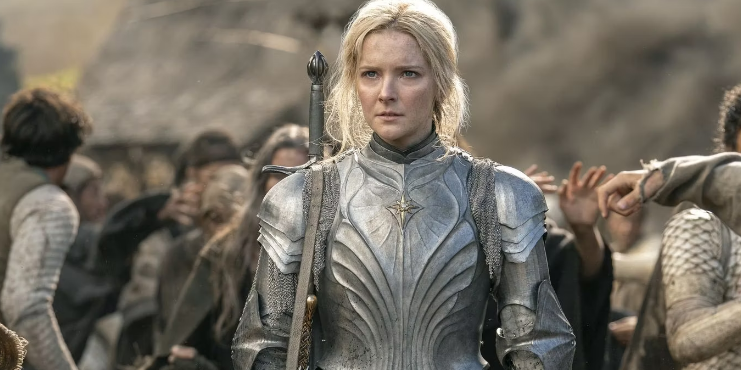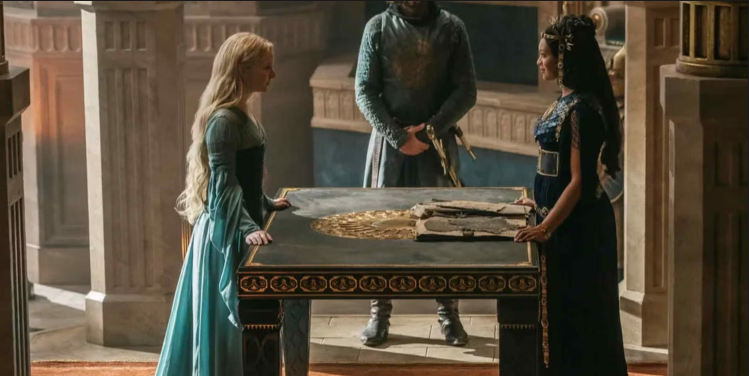Rings of Power: Why Did the Showrunners Choose Tokien’s Second Age?
J.D. Payne and Patrick McKay seek to develop and illuminate hidden histories woven into Tolkien’s Middle Earth.
The Lord of the Rings: The Rings of Power has been engulfed in what can only be described as a culture war ever since its release. With an audience score of less than 40% on Rotten Tomatoes, it can be difficult to separate true fandom disappointment from outright spite. Since the first season’s release, showrunners J.D. Payne and Patrick McKay appear determined to dispel widespread criticism of Rings of Power by giving expressive interviews and sharing their love for Tolkien’s work—which ultimately won them the show in the first place. The most striking comments from these interviews involve their cooperation with the family’s estate to describe the Second Age through film, an age which was not as extensively covered by Tolkien compared to events in the First and Third ages.
Little is known about the Second Age regarding the franchise’s most recognizable and immortal characters (Galadriel, Elrond, Sauron, Etc..). While most fans of The Lord of the Rings understand the impact of these characters in the overall timeline, there’s little about their early histories that can be known with total certainty. After all, the events of the Second Age span multiple centuries and geographical locations. So—in the blank spaces that were left behind—Payne and McKay seek to share their best interpretations of these characters with one of the largest audiences in television history.
So how did this all start? First, Amazon had to secure the rights to run an original Lord of the Rings series. HBO sought to make their own original content during this time as well, but their emphasis on spinoff shows and other stories taking place during Middle Earth’s Third Age was not appealing to the estate—especially since HBO would have full creative control. Amazon, however, offered to bring the estate into the writing room with some executive authority. Even though Amazon didn’t have any specifics in mind to start, Tolkien’s inheritors agreed to get on board.

Next, Amazon chose Payne and McKay to run the show because of their elevator pitch. When seeking a home for their project they would essentially ask networks/streaming companies, “what if we expand upon Galadriel’s monologue in the first five minutes of Peter Jackson’s The Fellowship of the Ring over the course of an entire series?” Amazon agreed to this pitch, then Tolkien’s estate set ground rules for what source materials could be used to create the series. Thus, Rings of Power was picked up and ultimately given the green light by Amazon and Tolkien’s inheritors.
While writing the new series, there has been one major setback for Payne and McKay in working directly with Tolkien’s estate—they do not have access to the Silmarillion. This means they are working near-exclusively within the perimeters of the Second Age. Knowing that this handicap exists may cause some critics to take pause. At most, these showrunners can make some references to the First Age but aren’t allowed to go much further than that.
Despite any restrictions, Payne and McKay remain resolved to craft an impactful narrative throughout the show’s five seasons. In an interview with Esquire (October 2022) they stated, “There are thousands and thousands of years of history. This was a man’s life’s work, and the canon is so labyrinthine.” They then continued by adding, “Working on the show has been a joy in seeing that there’s no end to it. There’s no bottom. Every leaf has a story.”
During their pitching process, both writers laid out maps of Arda and explained their need as storytellers to show the world how much of Tolkien’s imagination has been left out of popular cinema. Whether one is a fan of the new series or not, it cannot be denied that best efforts are being made to develop new-and-existing characters with all lore that is legally available to its creators.

Rings of Power is slated for five seasons and may come to surprise many Lord of the Rings fans by journey’s end. Although they act as first-time showrunners, Payne and Clark have an impressive 25year writing career in the industry, including work with J.J. Abrams on Star Trek: Into Darkness (2013), Disney’s Jungle Cruise (2021), and an unreleased Star Trek film with no title. Their work with Abrams is particularly notable, considering the intricacies of his earlier work and its potential influence on both writers.
As it stands, Payne and McKay seek to develop and illuminate hidden histories woven into Middle Earth’s rich lore. Their chosen area of focus is the twilight years of the Second Age. With guidance from Tolkien’s estate, they might be able to pull diehard fans back from the cusp of total war with Amazon’s flagship series. Will we eventually see flashbacks to Angbad, Balrogs, and the dark lord Melkor himself? According to the desires of these showrunners it’s beyond likely. However, they are limited by the fact that they cannot reference the Silmarillion directly.
In the next four seasons to come, it may turn out that many issues fans have had with the first season will be laid to rest. Like a Maiar appearing during times of great darkness to beat back drums from the deep, the closing statements of Payne and McKay’s love letter to Tolkien could very well dispel all doubts from here on out.




